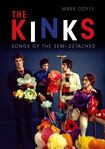
Mark Doyle stresses from the outset that this is not, in any sense, a biography of the Kinks but rather “an exercise in what I have decided to call historically informed rock criticism”.
Biographical details are used sparingly, with Ray Davies’s “unauthorised autobiography” X-Ray serving as a major source. Doyle knows he has to tread carefully here as that book features various literary tricks, not least an unreliable narrator (“the effect of which is to call into question whether anything in the book is actually true”). In short, biography serves as a mere backdrop for Doyle.
Despite its title, his work is less about the Kinks than it is a study of the art of Ray Davies seen through the prism of sociological research. As a result, the subsidiary Kinks are almost invisible. Drummer Mick Avory and bassist Pete Quaife are mere ciphers and even brother Dave Davies underperforms. His most famous song, Death of a Clown, does not receive a single mention, although its theme, a weariness of the false glamour of Swinging London, would have fitted well alongside Doyle’s astute observations of the city in the 1960s.
Though blessed with an encyclopaedic knowledge and a wealth of secondary sources, the author is surprisingly light on primary research. Despite research trips to the UK, he does not unearth any letters, manuscripts, arcane recordings, film treatments or previously unknown projects that might enlighten us. Instead the emphasis is on social history, with particular reference to class, kinship, mobility and the environment in which the Kinks operated, as well as previously undocumented influences that may have informed Davies’s songwriting.
Wisely, Doyle does not attempt to tackle the entire Kinks canon, focusing instead on the four major works of the late 1960s and early 1970s
There’s an engaging chapter on postwar affluence in north London, with a strong emphasis on the Davies family’s working-class upbringing. That said, there are some odd omissions. There is no reference to the UK’s tripartite system of education, which doomed all the Kinks to a non-academic schooling from the age of 11.
This is no small detail; it had a profound effect on their lives. They even produced an album covering the theme, Schoolboys in Disgrace, and previously referenced school experiences in brilliant songs such as David Watts and Do You Remember Walter? More surprisingly, there is precious little on Ray Davies’s art school years or any discussion of how his mingling with middle-class students affected his world view. This was a period when Davies was exposed to artists and film-makers, influences that are arguably worthy of a book in itself.
Major works
Wisely, Doyle does not attempt to tackle the entire Kinks canon, focusing instead on the four major works of the late 1960s and early 1970s: The Village Green Preservation Society, Arthur, Lola versus Powerman . . . and Muswell Hillbillies. This is fertile ground indeed.
The Village Green Preservation Society deserves endless scrutiny, and Doyle does not disappoint, teasing out its complexities and subversive aspects. Having already discussed the subtleties and nuances of Davies’s satire in songs such as A Well Respected Man and the album Face to Face, he notes perceptively that, by the late 1960s, “It became less clear just who or what he was satirizing, or if he was satirizing anything at all”.

Discussions of Davies's "Englishness" have inspired other writers to invoke Dickens, Orwell and Hogarth, but seldom, if ever, with the authority or scope offered here
While some myopic commentators have described the Village Green album as a reactionary statement or retreat into pastoral escape, Doyle sees it as pop art and ultimately a postmodern, avant-garde work. It is an intriguing and wholly original proposition, convincingly argued.
Discussions of Davies’s “Englishness” have inspired other writers to invoke Dickens, Orwell and Hogarth, but seldom, if ever, with the authority or scope offered here.
Searching for antecedents, Doyle cites John Betjemen and Philip Larkin, and even adds the 19th-century “peasant poet” John Clare to the list. While there’s no evidence to my knowledge that Davies ever read or even heard of Clare, their appreciation of village life and resistance to authority are well noted. Doyle provides a learned essay on the subject of enclosures but I would have liked to read more about Davies and Clare’s respective approaches to their art. If Davies was working in a pop tradition that challenged the norms of his time, then Clare too was grappling with different genres, a purveyor of mimetic Augustan poetics whose later work, particularly the poems written in madness, fully embraced a Romantic sensibility.
With Arthur, Doyle excels himself in his appreciation of the titular anti-hero. In one of Davies’s greatest compositions, Shangri-la, the songwriter captures the ennui of suburban living. The song is most remarkable for its tone, scathing and sympathetic in the same breath. It reflects Davies’s innate ability to view his characters from without and within, leaving the listener uncertain about his point of view, or even if he has one. Doyle encounters this trait again and again, proceeding tentatively, ever wary of Davies’s Janus smile and studied ambivalence. We are never entirely comfortable deciding whether Davies is sardonic or sincere. Most likely he is both. And if this wasn’t enough, Doyle concludes with an exhaustive mini-thesis on suburbia, which is digressive but all-encompassing.
Angry responses
The author interprets Lola versus Powerman . . . and Muswell Hillbillies as distinctly angry responses to personal and social issues, as Davies chronicles his disillusionment with the music business and rages about urban renewal. Doyle’s wide-ranging analysis takes in town planning, modern architecture, the seeds of Thatcherism and much more.
By the book's final section, the author has wandered further into undiluted social history
Kinks aficionados are likely to be challenged if not puzzled by the extent of Doyle’s learning. He is exceptionally well-read on poetry, politics and philosophy. “During the nineteenth century Burkean anti-rationalism became a central component of English national identity, particularly among the governing classes,” he writes.
The author proceeds along this abstruse route, tackling anti-Catholic movements of the 16th and 17th centuries, the intellectual campaign against the French revolution and a cast list of politicians, writers and social commentators including Stanley Baldwin, JA Hobson, JP Priestley and Edmund Burke. Having considered every aspect of his subject’s “Englishness”, he concludes that Davies is “more of an Orwellian socialist than a Burkean conservative”. It is difficult to argue otherwise.
By the book’s final section, the author has wandered further into undiluted social history. It’s academically sound, the scope is impressive but, paradoxically, the deeper Doyle delves, the greater distance we’re taken from the Kinks to a point where even the most insightful connections appear tantalisingly tenuous. It’s as if a completely new book is surfacing, overwhelming and threatening to displace the current one.
Finally, in the acknowledgements, the author provides an unexpected and belated clue to explain this reader's slight unease, offering a revealing thanks to the series editor John Scanlan, "who encouraged me to develop this book out of [what] was originally a very different project [italics mine]."
Johnny Rogan is the author of Ray Davies: A Complicated Life










